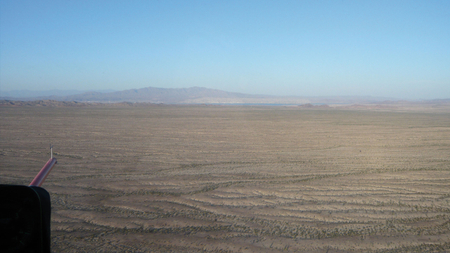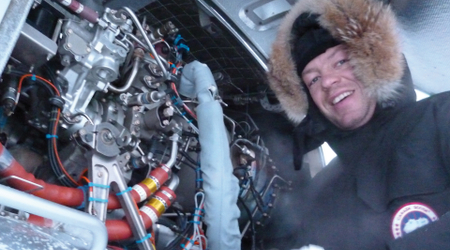Extreme tests for new EC 145 T2
EZM 10 and 103 Ti Ar on board high-performance Airbus Helicopters helicopter
The Technical Standard for Pilot’s Watches (TESTAF) was developed with the aid of the renowned helicopter manufacturer Airbus Helicopters along with other partners. Watches can be TESTAF certified if they meet all time measurement requirements for civilian flights operating under visual and instrument flight rules.

For TESTAF, which was initiated by Sinn Spezialuhren and drafted by the Faculty of Aerospace Technology at the Aachen University of Applied Sciences (FH) under Prof. Frank Janser, the FH test engineers developed numerous laboratory tests. The partnership with Airbus Helicopters made it possible to carry out extensive investigations during extreme flight tests conducted for the EC145 T2. This is Airbus Helicopters’ latest high-performance helicopter.
Determining the performance limits under extreme conditions
The approvals procedure for helicopters includes determining the performance limits under extreme conditions. Graduate engineer Michael Herr, Airbus Helicopters Vice President and National Quality Director Germany, and graduate engineer Volker Bau, Chief Test Pilot at Airbus Helicopters, were instrumental in carrying out the tests on our watches. Volker Bau and his team verified the theoretical findings in practical prototype testing of the EC145 T2. They conducted a wide range of investigations in hot and cold climate tests and in high-altitude experiments carried out in the deserts of the USA, in the Rocky Mountains and in the frozen wastes of Alaska. Permanently accompanying the pilots on board – or rather on their wrists – were our EZM 10 and 103 Ti Ar pilot’s watches. During the cold climate test, for instance, the watches were worn unprotected outside the pilot’s overall at temperatures down to minus 45°C.
Approval for new EC145 T2
A civil multi-mission and rescue helicopter, the EC125 T2 is the latest addition to the BK117 family. The machine offers greater engine power, a modified main gearbox, an ultramodern Fenestron (shrouded tail rotor) to counteract torque, and a large number of smaller modifications. The main focus in the development was on obtaining strong single-engine and high-altitude flight performance.The prototype had its maiden flight on 25 June 2010 in Donauwörth and was piloted by Volker Bau and Carl Ockier. To prove that the helicopter can be deployed anywhere in the world, it had to be tested in extreme environmental conditions. For this the helicopter was equipped with a state-of-the-art measurement system which can keep track of over 400 sensors. The data could then be monitored online by the engineers in the ground station, especially on critical flights. Depending on the flight programme, up to 150 test points were covered on each flight. The flights lasted up to two hours and demanded maximum concentration from the crew, especially when determining the performance limits of the helicopter. The data obtained during these flights was then used for the international approval and incorporated in the flight manual. Based on the results of the test flights, the EC145 T2 is approved for a temperature range of minus 40°C to plus 50°C and a maximum altitude of 20,000 ft (1 ft = 0.3048 m, 20,000 ft = 6,100 m).
Hot climate tests in the Desert of Arizona at an outside temperature of 48°C.

Hot climate tests
Lake Havazu in Arizona was chosen for the hot climate tests. The pilots subjected the helicopter to different tests in over 50 flying hours at temperatures of up to 50°C. Special emphasis was placed on possible engine failure and climbing up to 23,000 ft (= 7,010 m). Each flight required maximum concentration and commitment from the crew. The physical stress under these extreme conditions (cockpit temperatures of up to 60°C) matches that experienced by a half-marathon runner. A new aspect here was the special cooling shirts. These racing garments serve to keep the upper body cool. Cold water is pumped through a circulatory system sewn onto the shirt. Nevertheless, the pilots still had to drink plenty of water, especially during the hovering flight tests.

A pace vehicle was used to determine the flight characteristics at slower speeds. This is a vehicle equipped with wind sensors to measure the precise speed. The helicopter maintains a constant distance behind this vehicle (roughly 30 metres) to obtain a precisely defined reference speed. The position of the operating controls, the required control settings and the engine performance data then yielded the hovering properties of the helicopter.

Once the hot climate tests were completed the EC145 T2 was flown from Lake Havazu to the next test location in Leadville, Colorado. The ferry flight (transfer) involved flying past Lake Powel and Monument Valley to Montrose at the edge of the Rocky Mountains. The EC156 T2 has been specially modified for use at high altitude (for mountain rescue, including use with rescue winch) and so engine failure and flight characteristics were to be tested in Leadville. Leadville is North America’s highest airfield (9,927 ft = 3,026 metres above mean sea level). Living and working at an altitude of over 3,000 metres for 5 weeks posed a special challenge to the 10-man team. They quickly adjusted to the altitude, but time itself seemed to pass more slowly in the small mountain village of Leadville. Flying the prototype with the highly complex measurement equipment also required a great deal of improvisation. A windy and unheated corrugated steel hangar for the helicopter and a mobile office became the new home-from-home for the test team. They were rewarded, however, with an impressive and wild panorama of the Rocky Mountains, far away from Aspen, the ski resort of choice for the rich and famous.
Cold climate tests
Once the medium-altitude tests were completed in Canyon City, the helicopter was prepared at the Airbus Helicopters premises in Dallas for the long road journey through Canada. The helicopter was taken apart and loaded along with the measurement equipment onto two trucks for the 4,000 kilometre journey to Inuvik in the Northwest Territory of Canada – the final stretch being along the famous Ice Road. At certain points the trucks were only able to drive at 25 km/h and had to break their journey for almost a week because of snow storms.In summer the scenery around the village of Inuvik (population: roughly 3000) is spectacularly beautiful. In the winter months, however, the temperature plunges to minus 40°C. It is virtually impossible to survive outdoors without proper equipment, at least for Europeans. Yet the full test programme had to be completed. The helicopter was also subjected to “cold soak” tests. These involved leaving it outdoors for longer periods, generally overnight, and then demonstrating that it could start up immediately and set off on its mission. All work on the helicopter proved difficult, as it was almost impossible to handle the tools through the thick gloves. Most of the tasks had to be completed outdoors because the helicopter was only taken into the heated hangar for more comprehensive checks. The difference between the temperature inside the hangar and outside was 60 Kelvin. Each time the hangar doors were opened, therefore, resulted in considerable additional heating costs.
The purpose of many of the test flights was to document the flying performance. The heating even had to be turned off during some flights to obtain accurate data. The flights were undertaken at altitudes of over 20,000 ft (6,100 meters) at minus 45°C. The temperature in the cockpit went down to well below minus 30°C during these tests. This is why the crew was kitted out with thick clothing, parachutes and oxygen masks. The oxygen was specially chosen for high altitudes yet the perspiration in the mask froze repeatedly.

The crew was confronted with the problem of white-outs every time they landed. The downwash of the helicopter swirled up the snow which caught up with the helicopter at speeds of below 30 knots, depriving the pilot of any reference to his position. This meant that all he could see was a white wall, drastically raising the risk of his losing all sense of orientation – and crashing. At temperatures of minus 20°C the snow here is much drier and finer than the snow we are familiar with in Europe.
Summary
The EC145 T2, the EZM 10 and the 103 Ti Ar passed the extreme tests with flying colours. The innovative engineers of Airbus Helicopters and Sinn Spezialuhren have once again developed products which offer maximum mission and functional reliability. Equipped with the latest technology, they proved their worth in heavy-duty use under extreme conditions.
Freezer
As part of the approvals process the EC145 T2 was exposed to very low outside temperatures of minus 45°C for 24 hours. The approvals specifications state that the battery must be stored at a temperature of minus 20°C, i.e. approx. 25 Kelvin above the outside temperature. And so the technicians ordered a standard food freezer for storing the battery while in Inuvik. The local Inuits were clearly nonplussed and couldn’t help smiling to themselves. They normally store their frozen meat behind the house and not in a freezer. Nevertheless, they supplied the freezer as requested.
Technical specifications EC 145 T2
| Maiden flight | 25.06.2010 |
| Engines | 2 x Turbomeca ARRIEL 2E |
| Power | 2 x 800 kw |
| Maximum take-off weight (MTOW) | 3,650 kg |
| Unladen weight | approx. 2000 kg |
| Maximum speed (VNE) | 150 KIAS (knots) |
| Persons on board (POB) | 1 pilot + 9/10 passengers or 2 pilots + 8/9 passengers (depending on configuration) |
| Range | 650 km |
| Duration of flight | 3.5 hours |
| Temperature range | minus 45°C to ISA plus 35°C |


